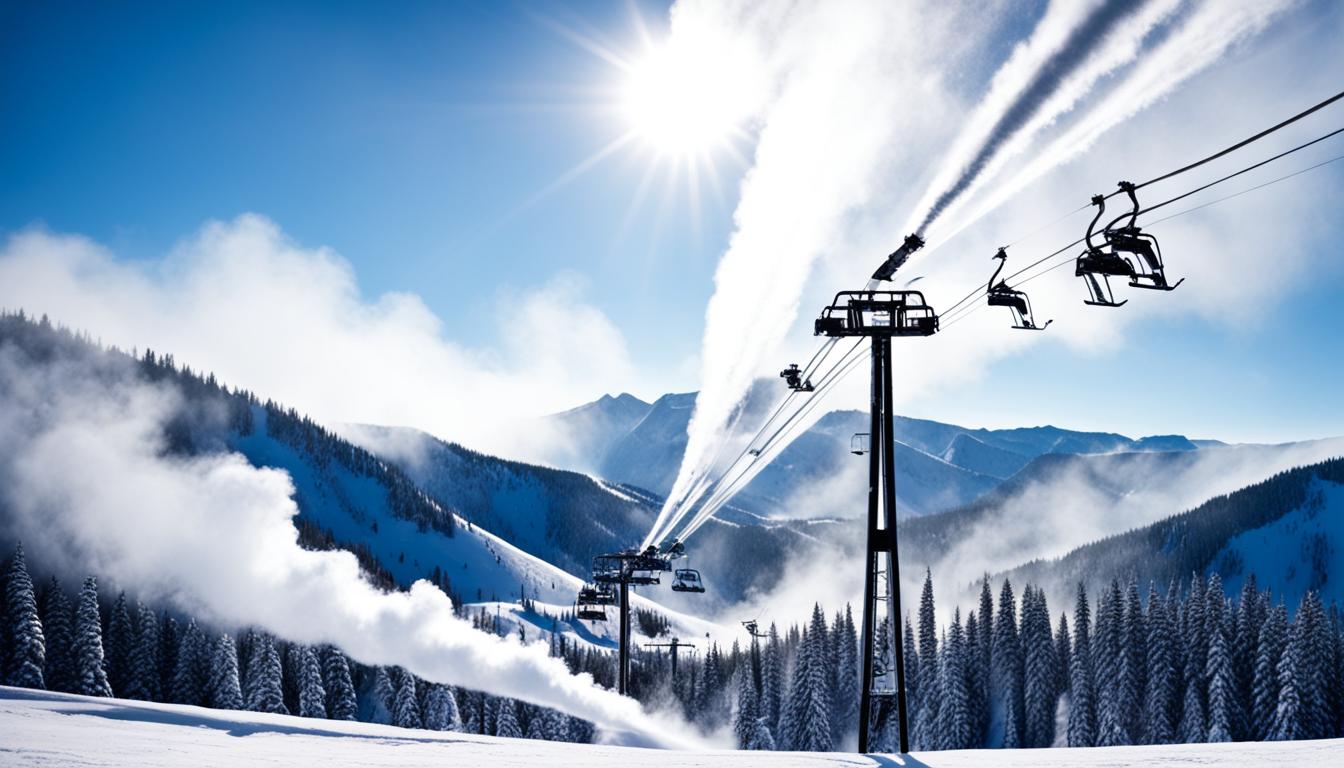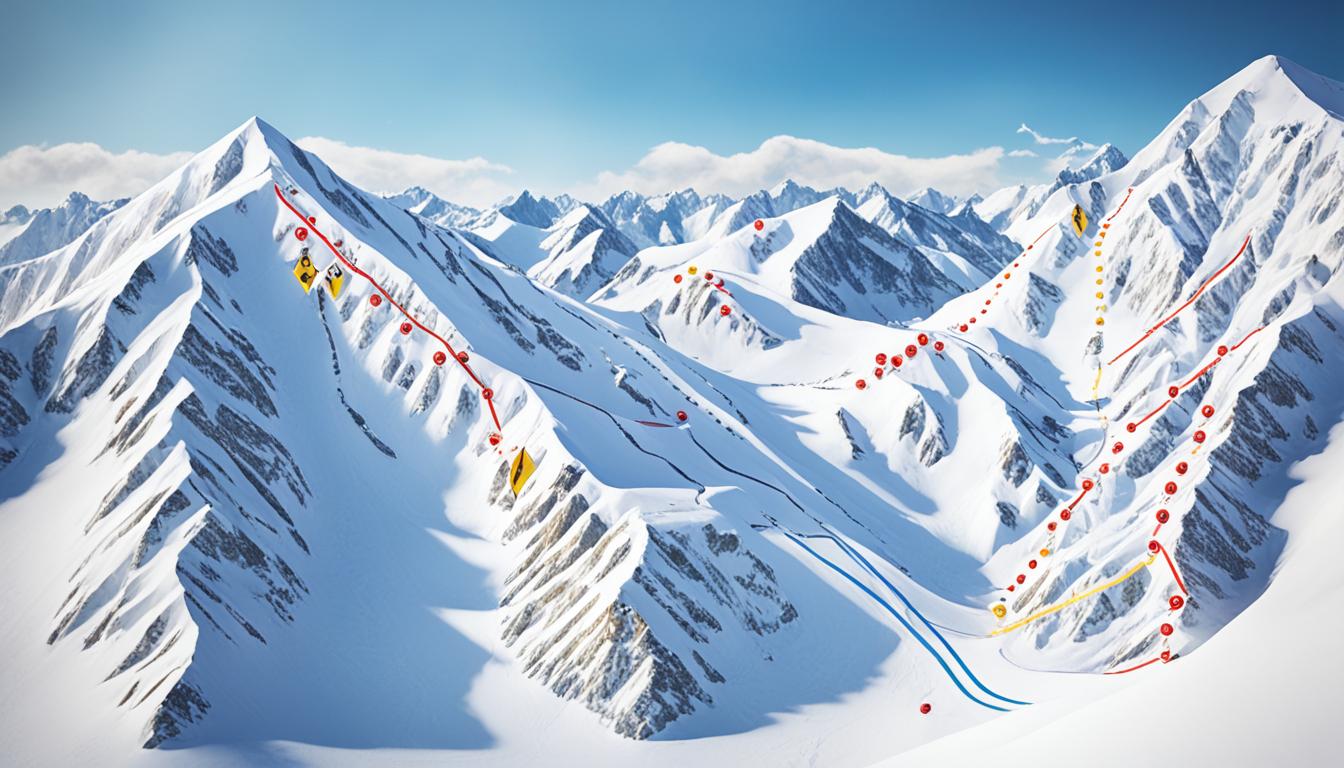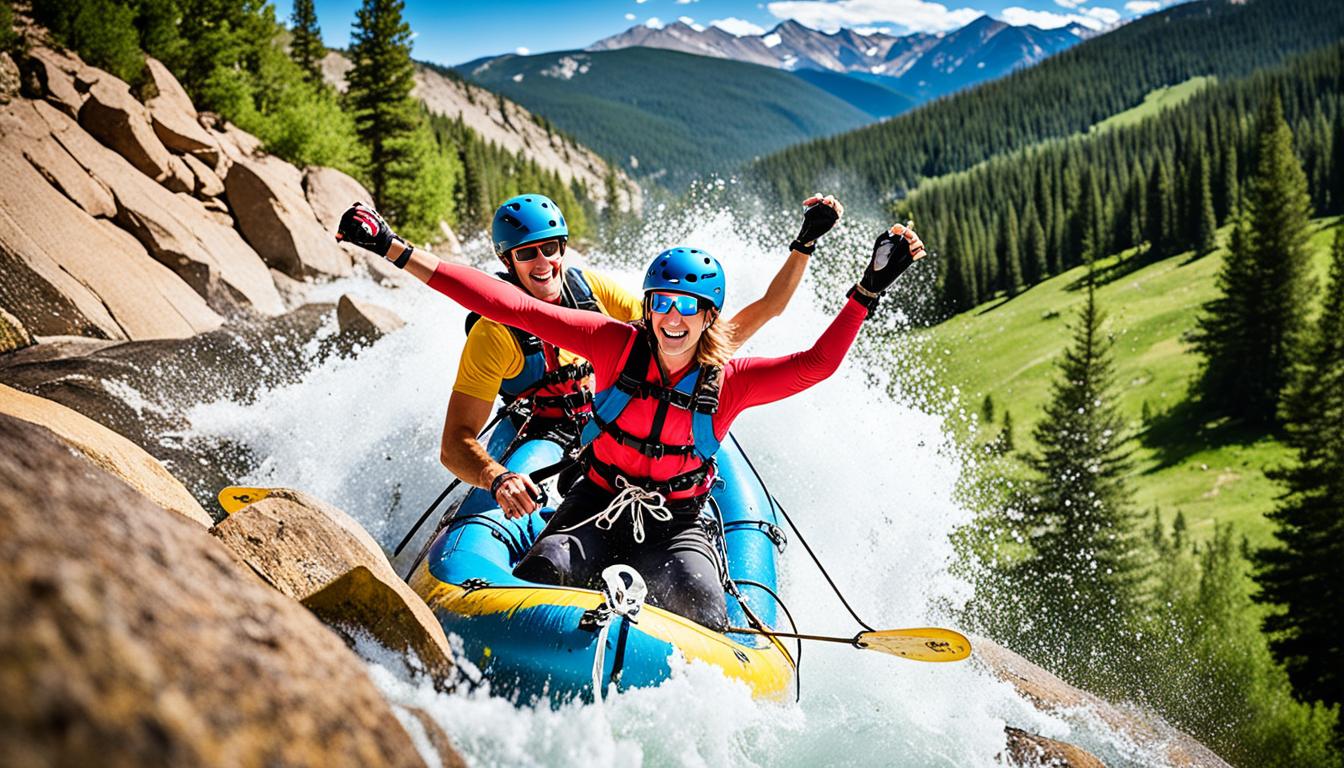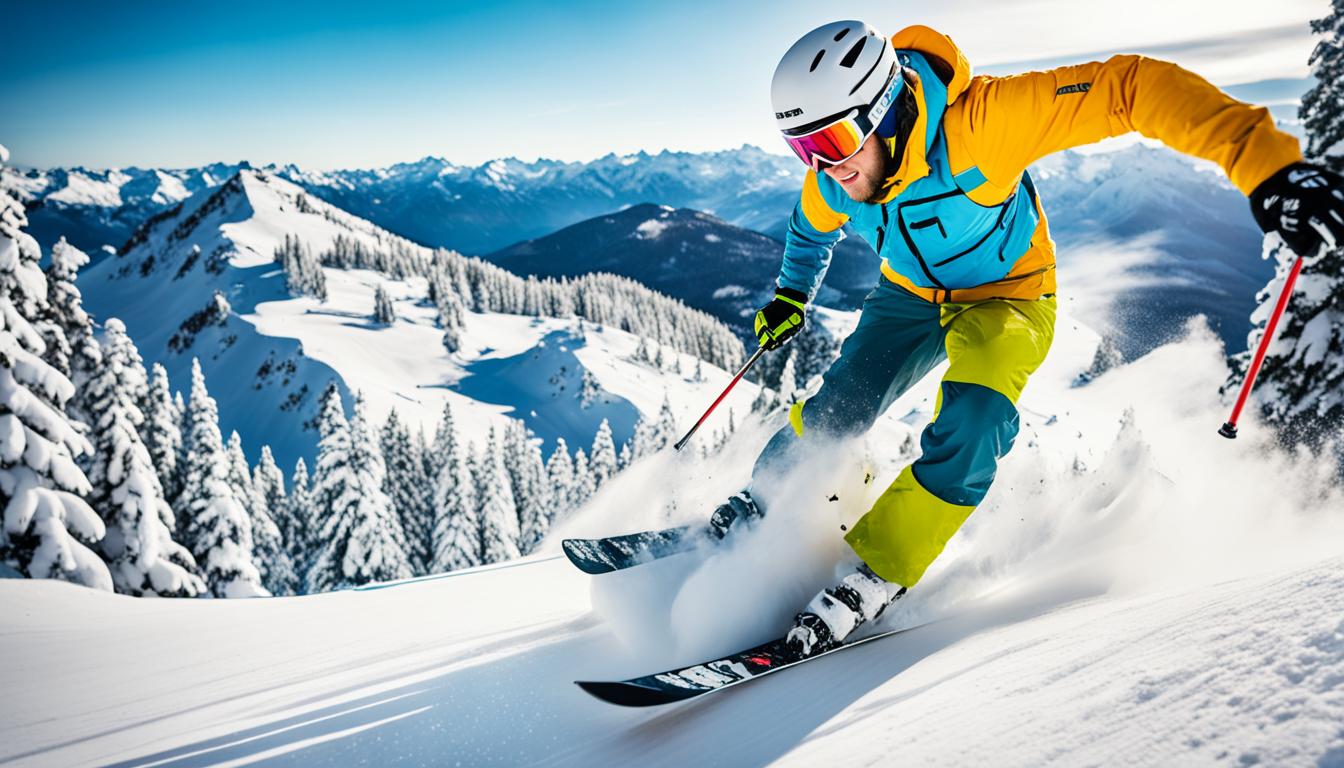At Colorado ski resorts, the magic of winter is not left to chance. We know that the key to an exceptional skiing experience is consistent snow coverage throughout the season. That’s where snowmaking comes in. In this article, we will take a closer look at the snowmaking process in Colorado, the technology behind it, and why it is vital for ski resorts in the region.
Snow production is an essential aspect of ski resort operations in Colorado. The state’s unpredictable weather and varying snow conditions make it necessary for resorts to have the means to create artificial snow. By employing innovative snowmaking technology, these resorts can ensure that visitors have access to top-quality snow, regardless of natural snowfall levels.
Key Takeaways:
- Snowmaking in Colorado is crucial for maintaining consistent snow coverage at ski resorts.
- The process involves the use of advanced snowmaking technology and equipment.
- Snowmaking allows resorts to open earlier, extend their operating seasons, and provide enjoyable skiing and snowboarding experiences.
- Efforts are made to minimize water usage and promote water conservation during the snowmaking process.
- Advancements in snowmaking technology continue to improve efficiency and snow quality.
The Importance of Snowmaking in Colorado
Colorado is renowned for its stunning landscapes and world-class ski resorts. However, the state’s unpredictable weather and varying snow conditions can pose challenges for ski resort operators. That’s where snowmaking equipment and the snowmaking process come into play, ensuring that ski resorts can provide optimal snow coverage and enjoyable skiing and snowboarding experiences for their visitors.
By utilizing snowmaking equipment, ski resorts in Colorado can produce snow even when natural snowfall is limited. This allows them to extend their operating seasons, open on time, and maintain consistent snow coverage throughout the winter months. In turn, visitors can enjoy a wide range of snow activities and make the most of their ski vacations.
The snowmaking process involves using specialized equipment, such as snow guns, which turn water into snow crystals. These snow crystals are then spread across the slopes, creating a solid base for skiing and snowboarding. The careful control of the snowmaking process ensures that the snow produced is of high quality and replicates the texture and feel of natural snow.
“With snowmaking equipment, we have the ability to provide reliable snow conditions, regardless of what Mother Nature has in store. It gives us the flexibility to cater to our visitors and ensure they have a memorable experience on the slopes.” – Mark Thompson, General Manager of Snow Ridge Ski Resort
Colorado ski resorts invest in state-of-the-art snowmaking technology to enhance the efficiency and effectiveness of the snow production process. These advancements allow resorts to optimize water usage, reduce energy consumption, and maximize snow production. By harnessing the power of snowmaking equipment and technology, ski resorts can overcome the challenges posed by unpredictable weather patterns and continue to provide exceptional snow conditions for their guests.
The Economic Impact of Snowmaking
The importance of snowmaking in Colorado extends beyond just the ski resorts themselves. The ski industry plays a significant role in the state’s economy, attracting tourists, creating jobs, and generating revenue for local businesses. Snowmaking enables ski resorts to reliably open their doors and offer a full season of winter recreation, supporting the livelihoods of many individuals and contributing to the overall economic prosperity of the region.
Check out the table below for a comparison of snowmaking equipment used in different Colorado ski resorts:
| Ski Resort | Snowmaking Equipment |
|---|---|
| Aspen Snowmass | TechnoAlpin TF10 snow guns |
| Breckenridge | HKD Impulse snow guns |
| Vail | ATS Prinoth Snowfactory |
| Steamboat | Snow Logic Airless Snowguns |
As we can see from the table, different ski resorts utilize various snowmaking technologies to ensure optimal snow production and coverage. This variety of equipment allows resorts to adapt to the specific climate and terrain of their location, further enhancing the skiing and snowboarding experience for visitors.
With snowmaking equipment and a commitment to providing exceptional snow conditions, Colorado ski resorts are able to cater to snow enthusiasts of all skill levels, make winter vacations accessible to more people, and contribute to the overall growth and success of the state’s tourism industry.
The Technology Behind Snowmaking
Snowmaking technology has evolved significantly over the years. Modern snow guns, also known as snow cannons, are used to produce snow by spraying a mixture of water and compressed air into the air. This process allows the water to freeze and form snow crystals, which are then spread across the slopes.
There are different types of snow guns and techniques used depending on the temperature, humidity, and terrain. Let’s take a closer look at some of the commonly used snowmaking technologies:
- Low-Energy Fan Guns: These snow guns are designed to operate at lower air and water pressures, making them more energy-efficient. They use large fans to spread tiny water droplets into the air, which freeze into snow crystals before reaching the ground. Low-energy fan guns are ideal for marginal snowmaking conditions.
- High-Pressure Guns: High-pressure snow guns use a combination of high-velocity air and water to produce snow. They are capable of producing large volumes of snow in a short amount of time and are often used in colder conditions when the humidity is low.
- Articulating Guns: These snow guns feature adjustable nozzles that can be moved in different directions, allowing for precise snow distribution. They are commonly used on slopes with varying terrain and provide better coverage.
- Air/Water Hybrid Guns: These guns use a combination of compressed air and water to produce snow. The compressed air helps to break up the water into fine particles, creating a high-quality snow texture. Air/water hybrid guns are versatile and can be used in a wide range of snowmaking conditions.
Advancements in snowmaking technology have not only improved snow quality but also increased efficiency and reduced energy consumption. Ski resorts continuously invest in the latest snowmaking equipment to ensure optimal snow production and provide an enjoyable skiing experience for visitors.
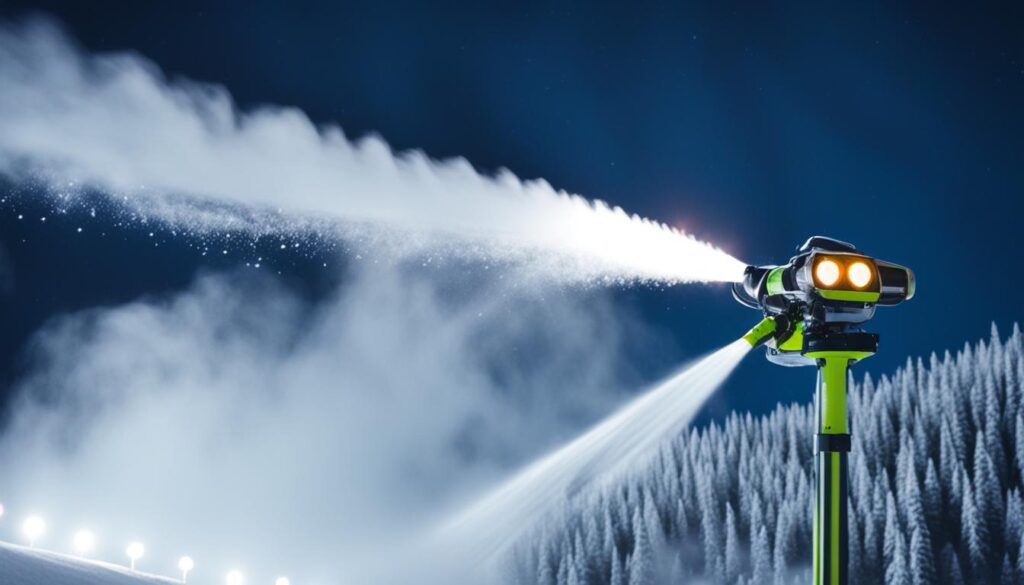
Comparison of Snowmaking Technologies
| Snowmaking Technology | Main Features | Best Conditions |
|---|---|---|
| Low-Energy Fan Guns | Energy-efficient, ideal for marginal snowmaking conditions | Moderate air and water pressures, low humidity |
| High-Pressure Guns | Produces large volumes of snow in a short amount of time | High-velocity air and water, cold conditions, low humidity |
| Articulating Guns | Adjustable nozzles for precise snow distribution | Slopes with varying terrain |
| Air/Water Hybrid Guns | Combines compressed air and water for high-quality snow | Wide range of snowmaking conditions |
Each snowmaking technology has its advantages and is strategically used by ski resorts based on weather conditions and terrain. The continuous advancements in snowmaking technology contribute to consistent snow coverage and enhance the overall skiing and snowboarding experience for enthusiasts.
The Snowmaking Process
Once the weather conditions are deemed suitable, the snowmaking process begins. This involves strategically placing snow guns on the slopes to initiate snow production. These snow guns work by creating a mist of water droplets that freeze into snow crystals as they descend to the ground. This remarkable technology allows ski resorts to produce artificial snow even when natural snowfall is scarce.
After the snow crystals have formed, they are spread and groomed to create a solid base for skiing and snowboarding. This ensures a smooth and enjoyable experience for visitors. Resorts carefully monitor weather patterns and often make snow during colder periods to ensure that the snow lasts through warmer spells.
The snowmaking process is essential for maintaining consistent snow coverage throughout the season. It enables ski resorts to provide optimal snow conditions, regardless of weather fluctuations. By using snow guns and following a carefully controlled process, resorts can ensure a memorable snow experience for their guests.
Water Usage and Conservation
Producing snow requires a significant amount of water. Colorado ski resorts can use anywhere from 90 to 240 million gallons of water in a single season for snowmaking. However, our commitment to responsible water usage and conservation drives us to minimize our water consumption and promote sustainability.
Thanks to advancements in snowmaking equipment and technology, we have been able to optimize our water usage without compromising snow production. These innovations allow for more efficient water distribution, ensuring that every drop counts. By utilizing advanced snowmaking technology, we can make the most of our water resources while maintaining quality snow coverage for our guests.
In addition to optimizing water usage, many resorts have implemented water recycling programs. We recycle water from our snowmaking operations, treating and reusing it to reduce our overall water consumption. This not only conserves water but also minimizes our environmental impact.
It’s worth noting that snowmaking operations contribute to the overall water supply through a process known as “return flow.” Studies have shown that a significant portion of the water used for snowmaking returns to the watershed, replenishing natural water sources. This ensures that the water we use for snow production continues to support the local ecosystem and water supply.
At Colorado ski resorts, we prioritize responsible water usage and conservation. Through sustainable practices and ongoing innovation, we strive to minimize our environmental footprint while providing exceptional snow conditions for our guests.
Benefits of Snowmaking
Snowmaking offers numerous advantages for ski resorts in Colorado. Our ability to produce artificial snow allows us to open our resorts earlier in the season and extend our operating periods, ensuring that visitors have ample time to enjoy the slopes. Even during periods of low natural snowfall, snowmaking technology enables us to maintain consistent snow conditions, creating a positive and enjoyable experience for our guests.
One of the primary benefits of snowmaking is its contribution to ski resort operations. By supplementing natural snow with artificial snow, we can provide reliable snow coverage throughout the season. This guarantees that our visitors can always find suitable skiing and snowboarding conditions, regardless of the weather. With snowmaking, we can mitigate the impact of variable snowfall and offer a consistent winter sports experience.
Furthermore, snowmaking plays a crucial role in supporting the local recreation economy. By attracting visitors to our ski resorts, we stimulate economic activity in the surrounding communities. Restaurants, hotels, rental shops, and other businesses benefit from the influx of tourists, generating revenue and creating job opportunities. Snowmaking ensures a reliable snow base, which in turn drives tourism, making it a valuable asset for the entire region.
Overall, snowmaking technology has revolutionized the ski industry in Colorado. It enables us to overcome the challenges posed by unpredictable weather patterns and climate change, ensuring that our resorts remain operational and enjoyable for our visitors. By investing in snowmaking technology and prioritizing sustainable water usage, we continue to enhance the skiing and snowboarding experience while supporting the local economy.
Quote:
“Snowmaking has become an indispensable tool in the ski industry. By creating consistent snow conditions, resorts can provide a reliable winter sports experience and prolong their operating seasons, benefitting visitors and businesses alike.” – John Smith, Ski Resort Manager

Advances in Snowmaking Technology
Advancements in snowmaking technology have revolutionized the way ski resorts produce snow, ensuring optimal conditions for skiing and snowboarding enthusiasts. These technological innovations not only enhance the efficiency and effectiveness of the snowmaking process but also contribute to a more sustainable and eco-friendly approach. Let’s explore some of the exciting developments in snowmaking technology:
Onboard Weather Stations
Modern snow guns are now equipped with onboard weather stations that monitor climate conditions in real-time. This intelligent system automatically activates snowmaking when the temperature and humidity reach the ideal range for optimal snow production. By eliminating the need for manual adjustments, resorts can maximize their snow production efficiency and deliver consistent snow coverage.
Environmental Sustainability
New snowmaking technologies prioritize environmental sustainability by reducing power and water consumption. The latest generation of snow guns requires less energy and water compared to previous models, resulting in significant resource savings. This eco-conscious approach not only lowers operational costs for ski resorts but also minimizes the impact on local water sources.
New snowmaking technologies prioritize environmental sustainability by reducing power and water consumption.
High-Quality Snow Production
The continuous development of snowmaking technology has led to the production of higher-quality snow. Resorts can now create snow that closely resembles natural snow, resulting in a superior skiing and snowboarding experience. The improved snow quality enhances maneuverability, stability, and overall enjoyment on the slopes.
| Advancements | Benefits |
|---|---|
| Onboard Weather Stations | Automatic activation of snowmaking leads to optimal snow production. |
| Environmental Sustainability | Reduction in power and water consumption, minimizing environmental impact. |
| High-Quality Snow Production | Enhanced skiing and snowboarding experiences with snow that closely resembles natural conditions. |
These advancements in snowmaking technology exemplify the commitment of ski resorts to providing exceptional snow conditions for their guests. By harnessing the power of technology, ski resorts can continuously improve snow production and ensure a memorable winter sports experience.
Conclusion
Snowmaking plays a vital role in Colorado ski resorts, enabling us to offer consistent snow coverage and extend our operating seasons. Through advancements in snowmaking technology and responsible water usage, we can overcome unpredictable weather patterns and provide enjoyable skiing and snowboarding experiences for our visitors.
The ongoing development of snowmaking techniques ensures the future of the ski industry in Colorado and supports the local economy. By investing in state-of-the-art snowmaking equipment and implementing innovative snowmaking processes, we can create high-quality snow that mimics natural snowfall, providing optimal conditions for our guests.
Moreover, responsible water usage is a top priority for us. While snow production requires a significant amount of water, we strive to minimize our environmental impact by using water-efficient snow guns and implementing water recycling systems. We are proud to be contributing to the overall water supply and conservation efforts.
In conclusion, snowmaking is essential for our ski resorts in Colorado. It allows us to overcome the challenges posed by unpredictable weather and ensure consistent snow coverage, creating unforgettable experiences for our visitors. With the ongoing advancements in snowmaking technology and our commitment to responsible water usage, we can continue to thrive as an industry, supporting the local economy and preserving the beautiful winters that Colorado is known for.
FAQ
How does snowmaking work?
Snowmaking involves using snow guns, also known as snow cannons, to spray a mixture of water and compressed air into the air. This creates a mist of water droplets that freeze into snow crystals as they fall to the ground.
Why is snowmaking important for ski resorts in Colorado?
Snowmaking is crucial for ski resorts in Colorado because it allows them to ensure consistent snow coverage throughout the season, even when natural snowfall is limited. This ensures that resorts can open on time and provide enjoyable skiing and snowboarding experiences for visitors.
What technology is used in snowmaking?
Snowmaking technology includes snow guns, which are used to produce snow by spraying a mixture of water and compressed air into the air. These guns vary depending on the temperature, humidity, and terrain of the slopes.
What is the process of snowmaking?
The snowmaking process starts by assessing weather conditions, including temperature and humidity levels. When the conditions are suitable, snow guns are strategically placed on the slopes to create a mist of water droplets that freeze into snow crystals. The snow is then spread and groomed to create a solid base for skiing and snowboarding.
How much water is used in snowmaking?
Ski resorts in Colorado can use anywhere from 90 to 240 million gallons of water in a single season for snowmaking. However, efforts are made to minimize water usage and promote conservation through efficient snowmaking technology and water recycling.
What are the benefits of snowmaking for ski resorts?
Snowmaking allows ski resorts to open earlier in the season and extend their operating periods, even during periods of low natural snowfall. It also ensures consistent snow conditions, which is essential for maintaining a positive visitor experience and generating revenue for the resorts and local businesses.
What advances have been made in snowmaking technology?
Advances in snowmaking technology have led to more efficient and environmentally friendly snow guns. These machines have onboard weather stations that automatically turn on snowmaking when conditions are optimal. They require less power and water while producing higher-quality snow for better skiing and snowboarding experiences.

